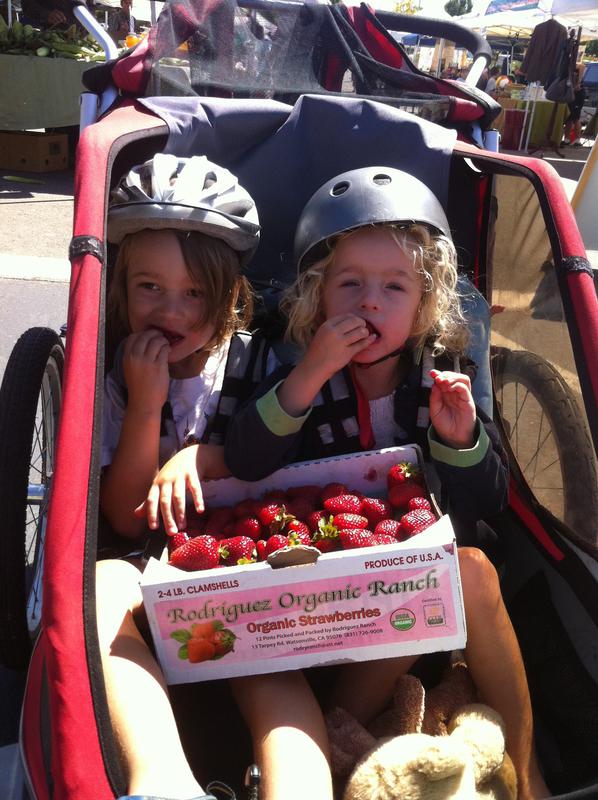Sometimes I think we are the only family at the grocery store that buys collard greens and kale. We go through the line and, inevitably, the checker has to look up the code on her laminated cheat sheet. I expect it now, and maybe I could do these long-suffering cashiers the favor of memorizing the PLUs myself. Then I top it off by paying with a food stamp card (now called SNAP—or is it EBT? Or, I think, CalFresh here in California? I can’t keep track anymore. I just know we are incredibly grateful to have it.) The cashiers usually get artificially chipper when I hand the card over, and, strangely, stop making eye contact.
When I first lost my job, we applied for emergency food assistance. Then, when I saw how little was provided for our family of five, I went into panic mode and bought the cheapest stuff I could find: a coffin-sized crate of ramen noodle packages, a box of Cheerios as big as an ottoman. No longer did I shop for the “best”—organic, free range, all natural (whatever that means)—I was now shopping for the cheapest.
And I was not alone in trying to negotiate this shift from affluent foodie to poverty-level mom just trying to feed her family on next to nothing. Take a look at the numbers and be startled along with me. As you can see, there was an unprecedented jump in participants in the program with the advent of the Great Recession in 2008. Suddenly, families who were unaccustomed to financial struggle joined the ranks of the truly needy. And we didn’t know how to shop for it! And still, after a few years of this New Poor culture, we are looked at with derision when we try to maintain our values as careful consumers and healthy eaters.
It’s surprising how many people will criticize your desire to buy healthy, unprocessed foods on government assistance, while they think nothing of subsidizing the nation’s dependence on medications for type-2 diabetes, high blood pressure, high cholesterol, and other illnesses with a lifestyle component. Thankfully, however, there are ways to make a mountain (of produce) out of a molehill (of money.)
First of all: in a genius and enlightened move, SNAP pays for food-bearing seeds to plant in your garden, if you’re lucky enough to have room for growing (we made space for raised beds by using our defunct driveway, an irony not lost on us.) I love the optimism the government has in my ability to nurture squash seeds to fruition! If you do your homework and learn everything you can about your own climate requirements, you can successfully supplement your family’s needs in this way. We have also had luck with an informal bartering system with our neighbors, trading our little micro-harvests to add to the variety.
Keep an eye out for fruit trees in your community, and work up the courage to approach neighbors. We’ve managed to incorporate loquats, Asian pears, and blackberries to supplement our own abundantly-productive fruit trees—and we get to return the generosity. Or if you want to be more official about it, register at neighborhoodfruit.com. Even if you don’t have trees of your own, you can certainly enjoy the excess of someone who may not know what to do with all those plums that ripen at once.
Until recently, we had temporarily shelved our healthy, happy habit of shopping at farmers markets. Though it is heartening to see the foot-hold they’re gaining in the mind of the mainstream grocery shopper (see the good news for yourself at https://content.govdelivery.com/bulletins/gd/USDAOC-e2ffc,) it was something we couldn’t enjoy as a family, as they were one of the few food outlets that didn’t take EBT cards. In a cheering development, that seems to be changing. Locally, our biggest farmers market-cum-swap meet has begun taking it as a form of payment for fresh produce. We are able to buy organic strawberries for half of what we’ve paid in our grocery store, and I can get a chance to interact with our local agricultural folks as well.
We still struggle with trying to avoid the cheap-and-easy route, especially when you can get white bread and Doritos for pennies. Sometimes, during especially stressful months—usually when it’s cold and rainy, the fruit trees are bare, and the paycheck comes in as thin and pitiful as ever—it’s tempting to just fill our family with what will satisfy their bellies. Happily, though, that happens less and less. It feels good to feed your children a rainbow of colorful produce every day, and it’s satisfying to not have to let go of that.









